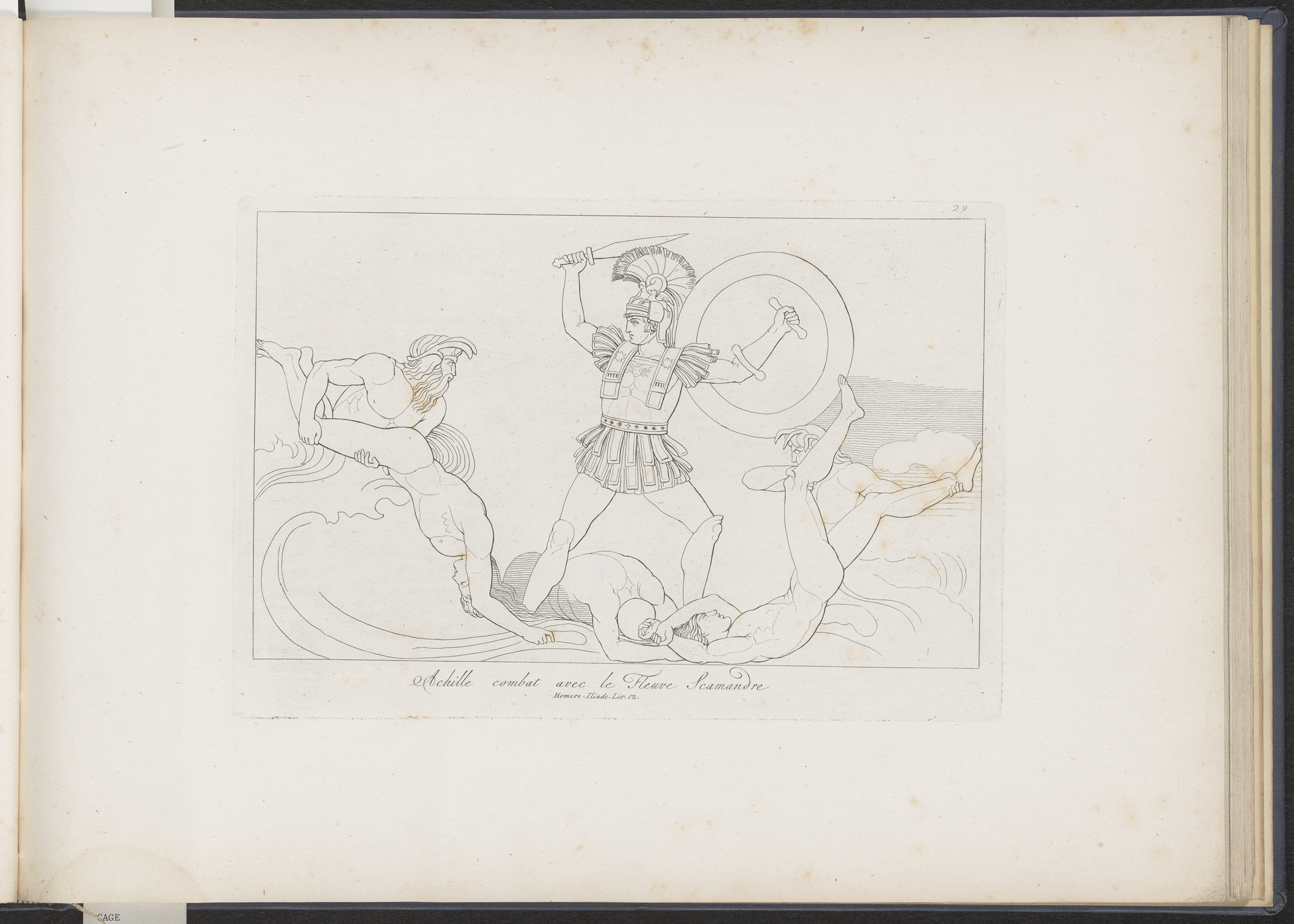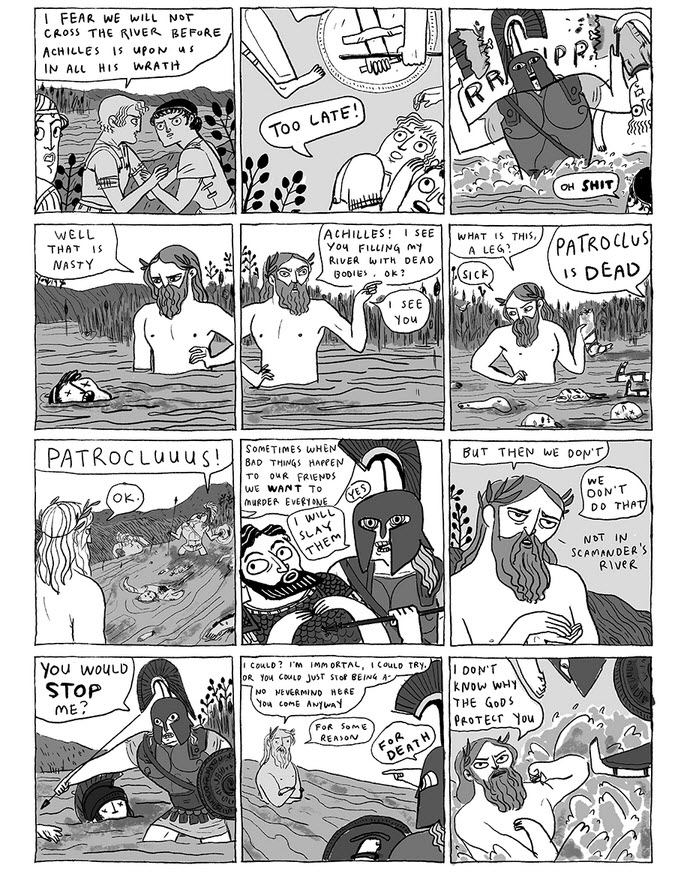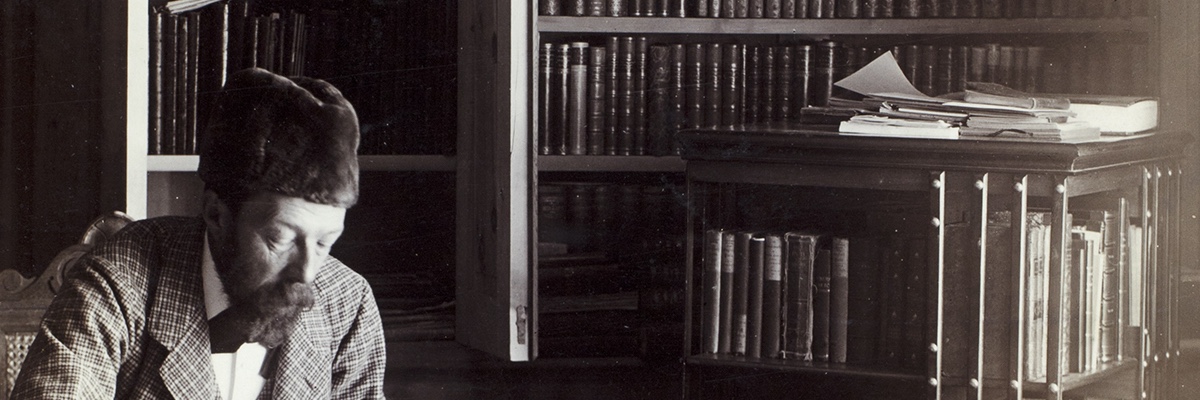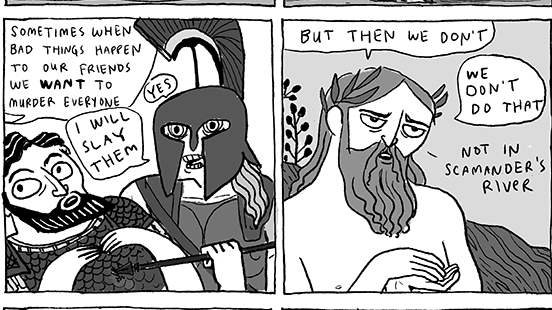During his studies—almost certainly at the Harrow School, and more extensively at Balliol College, Oxford—John Addington Symonds would have read the Iliad by Homer. There is much speculation and dissent, both by ancient writers and modern scholars, about the exact nature of the relationship between Achilles and Patroclus depicted by the text. At the time, it could have been considered through the lens of paiderastia. A relationship between an adult man, the erastês, and a younger one, often a teenager, the erômenos, paiderastia was a well-established institution in ancient Greece by the 4th century BC.1 However, the acceptability of this arrangement was not as prominent when Homer composed the Iliad. Although Symonds himself did not ascribe an erotic dimension to the heroic friendship between Achilles and Patroclus, their relationship is so easily read as such that it nonetheless functions as a keystone for understanding “Greek love.”
Symonds’ first encounter with the Iliad, and therefore the relationship between Achilles and Patroclus, was almost certainly during early childhood.
In his Memoirs, he discusses the artwork and texts available to him as a young boy, writing, “I was very fond of picture books and drew a great deal from Raphael, Flaxman and Retzsch. Our house was well stocked with engravings, photographs, copies of Italian pictures and illustrated works upon Greek sculpture.”2 The name surname Flaxman refers to John Flaxman, who was an eminent Neoclassicist sculptor and engraver.

The image above is taken from a collection of illustrations based on scenes from the Iliad, engraved by Thomas Piroli and based on John Flaxman’s line drawings. As a representation of one of the most famous Greek texts, Flaxman’s Iliad illustrations would have been important to the classical education of a young boy. So of all of Flaxman’s work, it is probable Symonds would have been able to access these; the book of engravings containing this scene almost certainly was present in Symonds’ childhood library. This particular image depicts Achilles in violent rage following his grief over the death of Patroclus. To avenge his fallen comrade, Achilles slaughtered dozens of Trojans in the river Xanthus:
But when they were now come to the ford of the fair-flowing river, even eddying Xanthus that immortal Zeus begat, there Achilles cleft them asunder… the Zeus-begotten left there his spear upon the bank, leaning against the tamarisk bushes, and himself leapt in like a god with naught but his sword; and grim was the work he purposed in his heart, and turning him this way and that he smote and smote; and from them uprose hideous groaning as they were anchorage in their terror, for greedily doth he devour whatsoever one he catcheth; even so cowered the Trojans in the streams of the dread river beneath the steep banks.3
Achilles killed so many Trojans, in fact, that the river god Scamander showed up to ask him to please stop:
The deep-eddying River waxed wroth and called to him in the semblance of a man, sending forth a voice from out the deep eddy: “O Achilles, beyond men art thou in might, and beyond men doest deeds of evil; for ever do the very gods give thee aid. If so be the son of Cronos hath granted thee to slay all the men of Troy, forth out of my stream at least do thou drive them, and work thy direful work on the plain. Lo, full are my lovely streams with dead men, nor can I anywise avail to pour my waters forth into the bright sea, being choked with dead, while thou ever slayest ruthlessly. Nay, come, let be; amazement holds me, thou leader of hosts.”4
Achilles would not, and decided to literally fight the river:
Then swift-footed Achilles answered him, saying: “Thus shall it be, Scamander, nurtured of Zeus, even as thou biddest. Howbeit the proud Trojan will I not cease to slay until I have pent them in their city, and have made trial of Hector, man to man, whether he shall slay me or I him.”5

Symonds’ interest in the image during childhood would have been rudimentary, and no doubt broadly curious rather than raptly speculative or scholastic. However, that his corpus draws substantially upon Achilles and Patroclus to discuss Greek love indicates that available representations in his early life made an impression. Despite Symonds’ statement in A Problem in Greek Ethics that “in the delineation of the friendship of Achilles and Patroclus there is nothing which indicates the passionate relation of the lover and the beloved,” their prominence in that text suggests some ambivalence.6 Symonds even mentions this specific scene: “The love for slain Patroclus broke his mood of sullen anger, and converted his brooding sense of wrong into a lively thirst for vengeance. Hector, the slayer of Patroclus, had to be slain by Achilles, the comrade of Patroclus.”7
Even if Achilles and Patroclus were not intended to be read as lovers, Greek writers after Homer represented them as such. In The Myrmidons, written in the fifth century BCE, Aeschylus portrayed Achilles as the erastês and Achilles as the erômenos. This portrayal is argued against in Plato’s Symposium, written in 4th century BCE–Phadedrus takes issue not with the fact that Aeschylus represents Achilles and Patroclus lovers, but argues against the paiderastic roles he assigns, insisting, “Aeschylus talks nonsense when he says that it was Achilles who was in love with Patroclus.”8 In other words, Aeschylus was incorrect to represent Achilles as the erastês. The long history of discourse around Achilles and Patroclus as a paragon of same-sex love render them a vital example in Symonds’ discussion.
Another interesting comment Symonds makes that complicates his position on Achilles and Patroclus as an example of “heroic friendship” rather than “Greek love” is that he goes on to suggest that “Greek love was, in its origin and essence, military.”9, 10 Achilles is a great warrior and military commander, and by far the most heroic figure in the Trojan War as represented in the Iliad. His initial response to Patroclus’s death—to go on a rampage—is as militaristic as response as one could possibly have. Given this definition of “Greek love,” it seems contradictory for Symonds to insist that Achilles’ dearest companion in life and battle could not also have been in some way a romantic partner, especially because Achilles insisted that his remains needed to be put in the same urn as Patroclus after he died.
Regardless of the Homeric representation of Achilles and Patroclus, the couple functioned as an important site of discussion and consideration during both classical antiquity and Symonds’ time. Achilles’ grief and rage at the death of Patroclus in the context of their broader relationship is just one of many pieces of evidence that Symonds used to evaluate whether they could be considered an example of paiderastia, but the event is a vital signal towards elements of the dynamic that cannot be dismissed merely as heroic friendship.
Endnotes
1 John Addington Symonds and Sean Brady, ed., “A Problem in Greek Ethics,” John Addington Symonds (1840-1893) and Homosexuality: a Critical Edition of Sources, (London: Palgrave Macmillan, 2012), 44.
2 John Addington Symonds and Amber K. Regis, ed., The Memoirs of John Addington Symonds: a Critical Edition, (London: Palgrave Macmillan, 2016), 118.
3 Homer and A. T. Murray, ed., The Iliad, (Cambridge, MA: Harvard University Press, 1924, via the Perseus Digital Library), 21.1-2,17-26.
4 Homer and Murray, The Illiad, 21.212-221.
5 Ibid, 21.222-226.
6 Symonds and Brady, “Greek Ethics,” 44.
7 Symonds and Brady, “Greek Ethics,” 45.
8 Plato and Harold N. Fowler, “Symposium,” Plato in Twelve Volumes, Vol. 9., (Cambridge, MA: Harvard University Press, 1925, via the Perseus Digital Library), 180b.
9 Symonds and Brady, “Greek Ethics,” 45.
10 Symonds and Brady, “Greek Ethics,” 50.
Works Cited
Homer. The Iliad. 1924. Translated by A.T. Murray. Cambridge, MA: Harvard University Press, in the Perseus Digital Library. Accessed April 22, 2019. http://data.perseus.org/citations/urn:cts:greekLit:tlg0012.tlg001.perseus-eng1:1.1-1.32
Plato. “Symposium.” 1925. Plato in Twelve Volumes, Vol. 9. Translated by Harold N. Fowler. Cambridge, MA: Harvard University Press, in the Perseus Digital Library. Accessed April 22, 2019. http://data.perseus.org/citations/urn:cts:greekLit:tlg0059.tlg011.perseus-eng1:180b
Piroli, Thomas. “Achille Combat avrec le Fleuve Scamandre ,” 1793. Line engraving, 35 x 45 cm. (Johns Hopkins Special Collections 730 X6 FOLIO c.1, Baltimore, MD). In L’iliade d’Homere gravée par Thomas Piroli d’apres les desseins composés par Jean Flaxman, sculpteur á Rome [Homer’s Iliad engraved by Thomas Piroli after drawings by Jean Flaxman, sculptor in Rome]. Book, printed in French. https://catalyst.library.jhu.edu/catalog/bib_2105108
Symonds, John Addington. 2012. “A Problem in Greek Ethics,” essay, in John Addington Symonds (1840-1893) and Homosexuality: a Critical Edition of Sources. Edited by Sean Brady. London: Palgrave Macmillan.
Symonds, John Addington. 2016. The Memoirs of John Addington Symonds: a Critical Edition. Edited by Amber K. Regis. London: Palgrave Macmillan.

